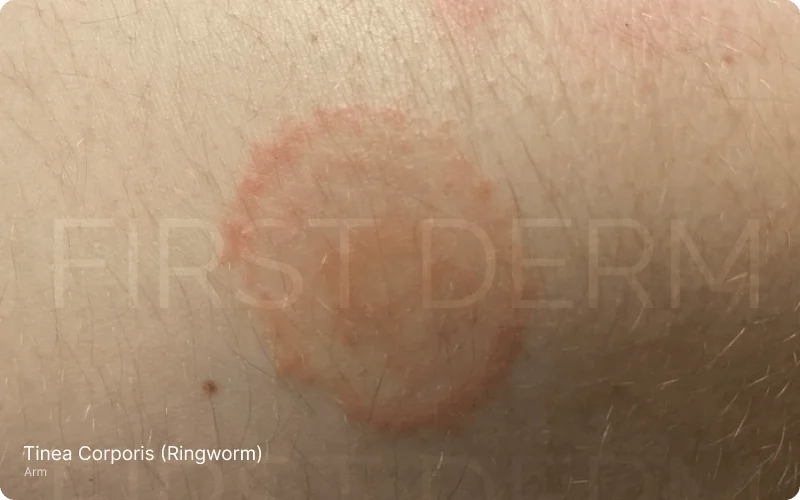Tinea Corporis (Ringworm)
Medically reviewed by The Dermatologists and written by Dr. Alexander Börve
Very Common millions US cases per year
- Requires medical diagnosis
- Symptoms: Scaly patches, itchy skin, ring- or circled-shape of raised pimples
- Color: Typically red
- Location: Anywhere on the skin
- Treatment: Antifungal medication
![Tinea Corporis (Ringworm) (01) skin [ICD-10 B35.4] Reddish ring shaped raised spots due to Tinea infection<br />](https://firstderm.com/wp-content/uploads/Tinea-Corporis-Ringworm-01-skin-ICD-10-B35.4.jpg)
A group of fungi called dermatophytes cause ringworm. Dermatophytes live off a substance called keratin, a tissue found in many parts of a person’s body, including the nails, skin, and hair. In ringworm of the body, the fungus infects the skin. Ringworm of the body is also called tinea corporis (the specific dermatophyte is tinea). Other related ringworm fungal infections have similar names, including:
- tinea pedis, commonly called athlete’s foot
- tinea cruris, also known as jock itch
- tinea capitis, also known as ringworm of the scalp
Try our FREE dermatology search engine and get peace of mind within a second
Symptoms

Ring-shaped, slightly raised, reddish rash indicative of tinea corporis (ringworm) on skin
The rash looks like a ring- or circled-shape of raised pimples and usually occurs on the face, arms, and legs. The surface is often scaly and the size can vary from a few millimeters to several centimeters. When the spots become larger, they begin to heal in the middle, and then get its characteristic ring shape. Symptoms of a more severe infection include rings that multiply and merge together. You may also develop blisters and pus-filled sores near the rings.
What can I do?
Applying topical fungicidal medications can relieve symptoms or treat the infection. There are over-the-counter brands you can use, including clotrimazole (Lotrimin AF), miconazole (Micatin), terbinafine (Lamisil), tolfaftate (Tinactin). Your pharmacist can help you choose which one is right for you. The following precautions should be taken to avoid ringworm infections:
- avoid sharing towels, hats, hairbrushes, and clothing with an infected person
- take your pet to see a vet if a ringworm infection is suspected
- if you are infected, be sure to maintain good personal hygiene around other people and avoid scratching the affected areas of your skin
- after a shower dry your skin well especially between the toes and where skin touches skin such as in the groin and armpits.
Should I seek medical care?
If you get an itchy rash that grows in size, you should contact your healthcare provider. Ringworm does not heal by itself and needs to be treated with fungicides. Fungicides are primarily used as topical cream, but sometimes also as tablets.
Treatment
Tinea corporis is contagious and susceptibility is increased with poor hygiene, skin and nail injuries, and excessive sweating. Creams can treat the infection. If the ringworm of the body is widespread, severe, or does not respond to the over-the-counter medicines, your doctor may prescribe a stronger topical medication or a fungicidal that you take by mouth. Griseofulvin is a commonly prescribed oral treatment for fungal infections.
Last updated on December 27, 2023
Sources
- Yee G, Al Aboud AM. Tinea Corporis. In: StatPearls. Treasure Island (FL): StatPearls Publishing; 2023. Updated August 8, 2023. Available at: https://www.ncbi.nlm.nih.gov/books/NBK544360/
- Centers for Disease Control and Prevention. Diagnosis & Testing of Ringworm. Fungal Diseases. https://www.cdc.gov/fungal/diseases/ringworm/diagnosis.html.
- NHS. Ringworm. https://www.nhs.uk/conditions/ringworm/. Last reviewed: August 3, 2023.
- Centers for Disease Control and Prevention. Ringworm Risk & Prevention. Fungal Diseases. https://www.cdc.gov/fungal/diseases/ringworm/risk-prevention.html. Last reviewed: November 29, 2022
- American Academy of Dermatology. Ringworm: Who gets and causes. https://www.aad.org/public/diseases/a-z/ringworm-causes.
- Centers for Disease Control and Prevention. Symptoms of Ringworm. Fungal Diseases. https://www.cdc.gov/fungal/diseases/ringworm/symptoms.html. Last reviewed: January 14, 2021
- Centers for Disease Control and Prevention. Treatment & Outcomes of Dermatophytes. Fungal Diseases. >https://www.cdc.gov/fungal/diseases/ringworm/treatment.html. Last reviewed: January 14, 2021
Ask a Dermatologist
Anonymous, fast and secure!

The Specialist doctor from the University Hospital in Gothenburg, alumnus UC Berkeley. My doctoral dissertation is about Digital Health and I have published 5 scientific articles in teledermatology and artificial intelligence and others.

